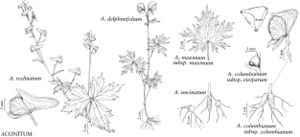Difference between revisions of "Aconitum maximum subsp. maximum"
FNA>Volume Importer |
FNA>Volume Importer |
||
| Line 16: | Line 16: | ||
}}<!-- | }}<!-- | ||
| − | --><span class="statement" id="st- | + | --><span class="statement" id="st-undefined" data-properties=""><b>Roots </b>tuberous, tubers distally bulbous, 20-50 × 5-20 mm, parent and daughter tubers separated by connecting rhizome usually 10-15 mm. <b>Stem</b> erect, ca. 3-20 dm. <b>Cauline</b> leaves: blade 3-divided with more than 2 mm leaf tissue between deepest sinus and base of blade, 5-20cm wide, segment margins deeply cleft and toothed. <b>Inflorescences</b> racemes or panicles, terminal portion often contracted and capitate. <b>Flowers</b> blue, purple, or occasionally bluish white, 25-50 mm from tips of pendent sepals to top of hood; pendent sepals ca. 15 mm; hood conic-hemispheric, ca. 17 mm from receptacle to top of hood, ca. 20 mm wide from receptacle to beak apex.</span><!-- |
-->{{Treatment/Body | -->{{Treatment/Body | ||
| Line 22: | Line 22: | ||
|habitat=Meadows, thickets, and forests | |habitat=Meadows, thickets, and forests | ||
|elevation=0-300 m | |elevation=0-300 m | ||
| − | |distribution=Alaska;Asia (Russian Far East and Japan) | + | |distribution=Alaska;Asia (Russian Far East and Japan). |
|discussion=<p>Aconitum maximum subsp. maximum is a variable species. The only other species of Aconitum occurring with it on the Alaska Peninsula and the Aleutian Islands is A.delphiniifolium. Aconitum maximum subsp. maximum is reputedly extremely poisonous and was used as a source of arrow poison by the Aleuts (D. E. Moerman 1986; D. E. Brink 1982).</p> | |discussion=<p>Aconitum maximum subsp. maximum is a variable species. The only other species of Aconitum occurring with it on the Alaska Peninsula and the Aleutian Islands is A.delphiniifolium. Aconitum maximum subsp. maximum is reputedly extremely poisonous and was used as a source of arrow poison by the Aleuts (D. E. Moerman 1986; D. E. Brink 1982).</p> | ||
|tables= | |tables= | ||
| Line 42: | Line 42: | ||
|habitat=Meadows, thickets, and forests | |habitat=Meadows, thickets, and forests | ||
|elevation=0-300 m | |elevation=0-300 m | ||
| − | |distribution=Alaska;Asia (Russian Far East and Japan) | + | |distribution=Alaska;Asia (Russian Far East and Japan). |
|reference=None | |reference=None | ||
|publication title= | |publication title= | ||
|publication year= | |publication year= | ||
|special status=Selected by author to be illustrated | |special status=Selected by author to be illustrated | ||
| − | |source xml=https://jpend@bitbucket.org/aafc-mbb/fna- | + | |source xml=https://jpend@bitbucket.org/aafc-mbb/fna-data-curation.git/src/9216fc802291cd3df363fd52122300479582ede7/coarse_grained_fna_xml/V3/V3_601.xml |
|genus=Aconitum | |genus=Aconitum | ||
|species=Aconitum maximum | |species=Aconitum maximum | ||
|subspecies=Aconitum maximum subsp. maximum | |subspecies=Aconitum maximum subsp. maximum | ||
| − | |||
| − | |||
| − | |||
| − | |||
| − | |||
| − | |||
| − | |||
| − | |||
| − | |||
| − | |||
| − | |||
| − | |||
| − | |||
| − | |||
| − | |||
| − | |||
| − | |||
| − | |||
| − | |||
| − | |||
| − | |||
| − | |||
}}<!-- | }}<!-- | ||
-->[[Category:Treatment]][[Category:Aconitum maximum]] | -->[[Category:Treatment]][[Category:Aconitum maximum]] | ||
Revision as of 14:44, 27 July 2019
Roots tuberous, tubers distally bulbous, 20-50 × 5-20 mm, parent and daughter tubers separated by connecting rhizome usually 10-15 mm. Stem erect, ca. 3-20 dm. Cauline leaves: blade 3-divided with more than 2 mm leaf tissue between deepest sinus and base of blade, 5-20cm wide, segment margins deeply cleft and toothed. Inflorescences racemes or panicles, terminal portion often contracted and capitate. Flowers blue, purple, or occasionally bluish white, 25-50 mm from tips of pendent sepals to top of hood; pendent sepals ca. 15 mm; hood conic-hemispheric, ca. 17 mm from receptacle to top of hood, ca. 20 mm wide from receptacle to beak apex.
Phenology: Flowering summer (mid Jul–Sep).
Habitat: Meadows, thickets, and forests
Elevation: 0-300 m
Distribution

Alaska, Asia (Russian Far East and Japan).
Discussion
Aconitum maximum subsp. maximum is a variable species. The only other species of Aconitum occurring with it on the Alaska Peninsula and the Aleutian Islands is A.delphiniifolium. Aconitum maximum subsp. maximum is reputedly extremely poisonous and was used as a source of arrow poison by the Aleuts (D. E. Moerman 1986; D. E. Brink 1982).
Selected References
None.
